Geoscience Reference
In-Depth Information
of the surrounding geology, need to be considered during
survey design. Geophysical modelling, whereby the geo-
physical response of a numerical model of the subsurface is
computed (see
Section 2.11
)
, provides information about
the nature of the geophysical response of the expected
subsurface geology useful for survey design.
For a speci
c subsurface feature, including topography,
the survey system and con
guration most capable of
detecting the feature and yielding the required information
about it can be determined from modelling. This is par-
ticularly important for the electrical and electromagnetic
methods where a great diversity of survey systems is avail-
able and a great diversity of survey configurations is pos-
sible. For a particular survey system and configuration, a
suitable sampling interval can be determined; the effects of
changes in target parameters on the response can be
assessed and those having the greatest or the least in
2.6.3.3
Survey configurations
Data acquired along a single survey traverse or in a drill-
hole form a one-dimensional (1D) (spatial) data series,
because variations in the measured parameter are depicted
in only one direction. A time series is also a 1D data series.
A group of 1D spatial series or a random distribution of
measurements across a surface can be combined to form a
two-dimensional (2D) data series. In this case, the data are
presented as a map in terms of two spatial coordinates
(easting and northing, or latitude and longitude). Most
above-ground surveys are 2D and provide a map showing
the spatial variation of the parameter measured.
Some common 2D geophysical survey con
gurations
are shown in
Fig. 2.10
. The measurement locations are
a)
Straight traverses
uence
identi
ed. The amplitude of the response can be used to
estimate the acceptable level of noise.
Modelling is an important aid in the design of cost-
effective and ef
cient surveys, and its role should not be
underestimated. However, it is only as good as the assump-
tions that are necessarily made about the geological envir-
onment to be surveyed, which in the early stages of
exploration may be highly speculative.
Tie line
Irregular traverses
b)
2.6.3.2
Survey height
The height of the survey system above the ground is an
important parameter in all types of airborne geophysical
surveys. Survey aircraft are equipped with radio altimeters
to record the aircraft
c)
Square grid
is ground clearance. This is the
survey height or flight height above the ground, which
usually varies according to the topography, so it
'
is
speci
ed as the mean terrain clearance (MTC) of the
survey. Lower survey height reduces the system footprint
(see
Section 2.6.2
)
, improves spatial resolution and
increases the strength of the signal (see
Section 2.3
).
Operational constraints, however, dictate the minimum
MTC; and lower survey height is not always an advantage,
as close proximity to near-surface sources increases their
short-wavelength responses, which may be a source of
noise (see
Section 2.4.1
)
. A small station interval is
required to sample these properly (see
Section 2.6.1
).
Even if this is achieved it can be dif
cult to correlate the
responses between the survey lines, making gridding dif-
ficult (see
Section 2.7.2
) and possibly masking responses
from the underlying geology.
d)
Random
Figure 2.10
Some common con
gurations for geophysical surveys.
The dots represent data points. (a), (b), Various traverse or line
con
gurations; (c) grid network; and (d) con
guration typical of
ground-based regional surveys.

































































Search WWH ::

Custom Search